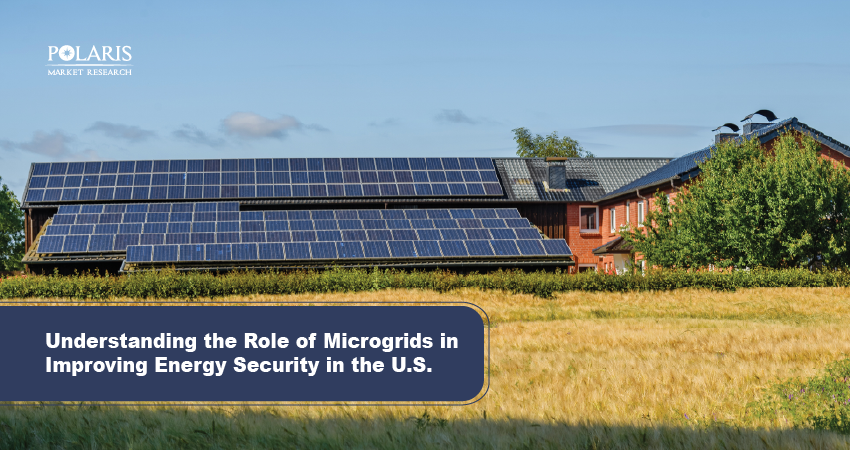Understanding the Role of Microgrids in Improving Energy Security in the U.S.

Energy systems are evolving to cater to the needs of a more sustainable future. Microgrids have emerged as a key solution in the changing energy landscape. With their ability to operate independently or along with the main power grid, microgrids provide improved reliability and efficiency. From rural electrification to urban campuses, the use of microgrids is transforming the way energy is distributed and consumed.
In this blog post, we explain the fundamentals of microgrids and how they work. We also cover the benefits and applications of microgrids. Additionally, we shed light on the key stats of the U.S. microgrid market. Read on!
Microgrid: Overview
A microgrid is a small-scale power grid. It is characterized by its ability to function independently from the main electricity grid. Microgrids serve a definite set of users. These users may take the form of a hospital, business center, housing complex, or production facility. Microgrids provide a flexible way to improve reliability. A notable thing about microgrids is that they can be configured to prioritize renewable energy sources, including wind, solar, and hydrogen fuel cells.
Key Components of a Microgrid
Several energy technologies are in place to enable the operation of a microgrid. Each of these energy technologies consists of several key components. Below, we’ve explained them in detail:
Power Sources: As the name suggests, power sources are the generators that generate electricity for the microgrid. Power sources may take the form of renewable sources such as wind turbines and solar panels. Nonrenewable sources, such as diesel or natural gas generators, may also take the form of power sources in some microgrids.
Energy Storage Systems: Microgrids make the use of energy storage systems like flywheels or batteries for storing excess power. The stored energy can be used when there is peak demand or during intermittent power generation periods.
Distribution Infrastructure: The distribution infrastructure encompasses the equipment needed for the distribution of power to the loads from the sources. The loads can take the form of switches, transformers, and power lines.
Control Systems: Control systems act as the “brain” of the microgrid. It manages the operation of the grid and balances the power supply. Additionally, it facilitates the integration of renewable sources and maintains power quality. Furthermore, it facilitates disconnection and reconnection to the main power grid as required. Control systems encompass various load management tools for adjusting supply as needed. Measuring devices are also a part of these systems and provide crucial information for the effective management of the grid’s operations.
Benefits of Microgrids
There are several benefits associated with the use of microgrids. Their use helps improve energy resilience and promotes sustainability. Below, we’ve explained to you the benefits of microgrids in detail:
Improve Energy Resilience
Microgrids help improve energy resilience by making it possible to produce and distribute power locally. This is vital for areas that experience frequent grid outages or are prone to natural disasters. Here, microgrids can ensure continued electric supply to key infrastructure such as emergency services, hospitals, and community centers.
Renewable Energy Integration
Many microgrids prioritize the integration of renewable energy sources. This integration helps lower the dependency on fossil fuels. Additionally, it helps reduce greenhouse gas emissions. That way, it’s possible to combat climate change and contribute to the conservation of the environment.
Cost Savings and Efficiency
The ability of microgrids to optimize the production and distribution of energy at the local level can help improve efficiency and save costs. Their use reduces the transmission losses associated with the delivery of power over long distances. Additionally, it’s possible to leverage energy storage technologies that store excess power.
Key Market Metrics
Our latest analysis reveals the U.S. microgrid market to register robust growth in the coming years. The market for microgrids in the U.S. stood at USD 24.71 billion in 2024. It is anticipated to register a CAGR of 15.8% between 2025 and 2034.
Applications of Microgrids
Microgrids are essential for improving energy security and providing a reliable power supply in remote locations. Below, we’ve explained to you the various applications of microgrids:
Remote Communities
Microgrids serve as a key solution for remote locations that have limited access to a central power infrastructure. They provide a reliable and sustainable source of energy in off-grid regions. Their use promotes economic development and improves community resilience.
Industrial and Commercial Facilities
Microgrids also find applications in industrial and commercial units. They are used for ensuring a reliable power supply and reducing the impact of grid disruption on key operations. Additionally, the use of microgrids provides businesses with improved control over their energy supply.
Military Installations
Military bases use microgrids for improving energy security and operation readiness. Self-sufficient energy systems help reduce dependence on external power sources that may be vulnerable. Their use also improves overall resilience in challenging environments.
The Advent of AI-Powered Microgrids
In recent years, the world has seen the advent of microgrids powered by artificial intelligence (AI). These AI-powered microgrids and smart grids help improve energy reliability by integrating data about various aspects, including market prices, weather forecasts, and energy consumption. AI also helps manage the intermittent nature of renewable energy sources by forecasting energy generation patterns and optimizing storage utilization. Furthermore, the ability of AI to optimize charging and discharging cycles in microgrids helps extend their lifespan and maximize their efficiency. Artificial intelligence helps address other microgrid challenges, including data dependency, integration and scalability, and cybersecurity risks.
Conclusion
To conclude, microgrids offer a resilient and sustainable power solution needed for various applications. They represent a major shift in the way energy is managed. As energy storage technologies advance and sustainability garners increased attention in the energy industry, the U.S. microgrid market demand is expected to rise in the coming years.

